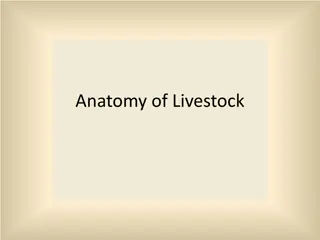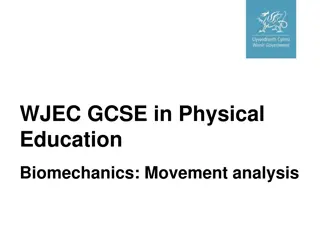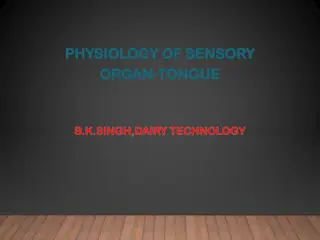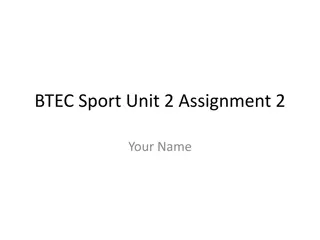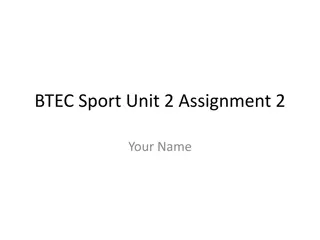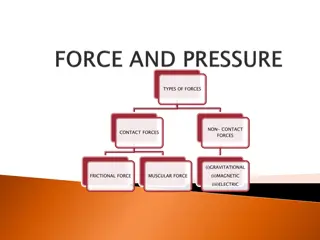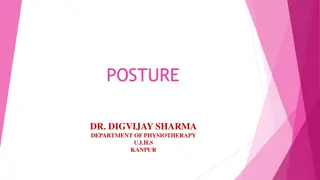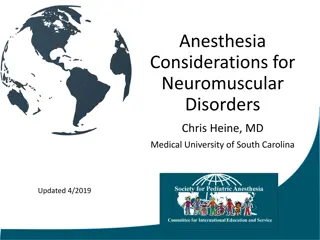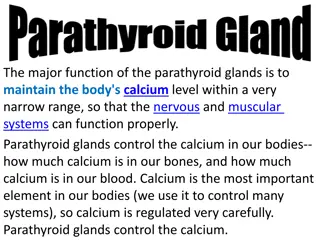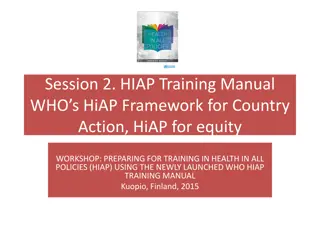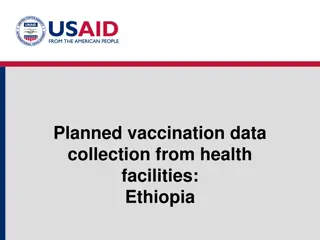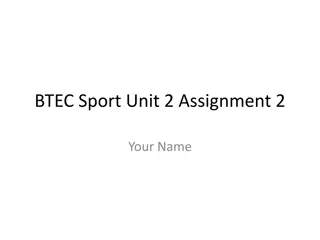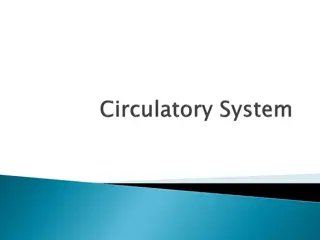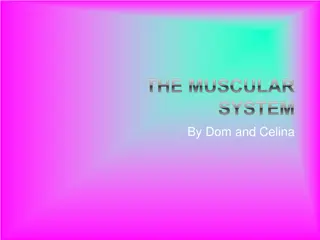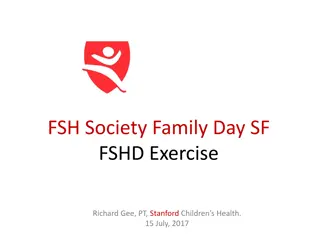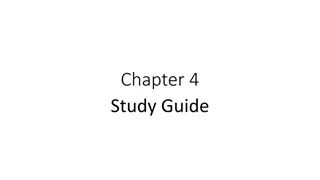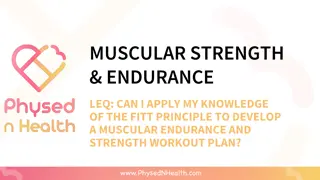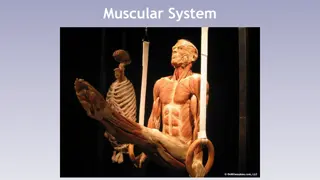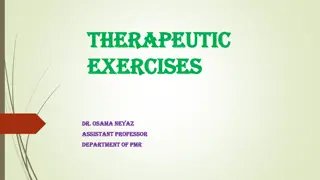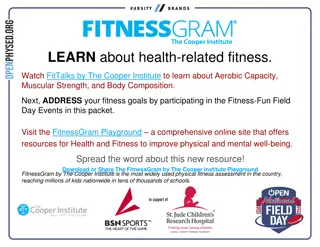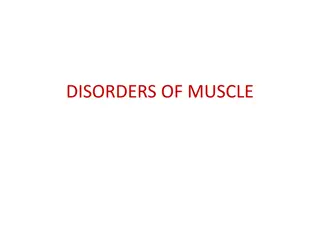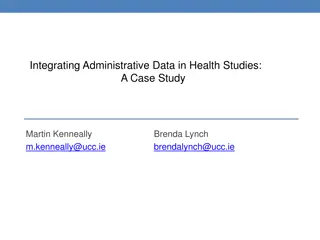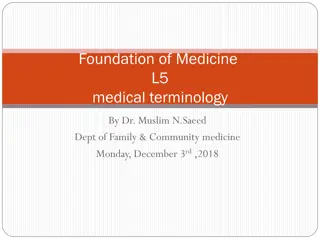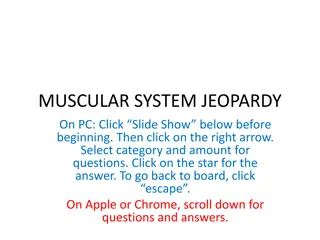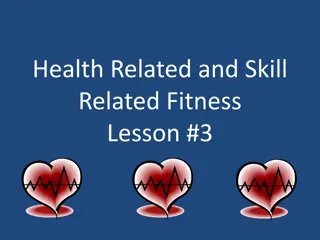Importance of Fitness Testing in Physical Education
Health-related physical activity (HRPA) stresses the need to view fitness testing as a tool to promote increased physical activity levels rather than an end goal. The focus in school physical education is on equipping youth with the knowledge and skills for lifelong health. Fitness test protocols sh
0 views • 17 slides
The muscular system
The muscular system is a vital organ system that includes smooth, skeletal, and cardiac muscles. It plays a crucial role in locomotion, supporting the cardiovascular system, enabling lung ventilation, regulating fluids, maintaining posture, and generating heat in the body. This system consists of ar
2 views • 16 slides
Assessment and Diagnostic Tests in Musculoskeletal System Pain
Pain in musculoskeletal conditions varies, such as bone pain described as dull and deep, muscular pain as soreness, fracture pain as sharp, and joint pain worsens with movement. Specific assessments by nurses include checking body alignment, joint symmetry, signs of inflammation, pressure sources, a
7 views • 38 slides
Aerobics Training: Introduction, Benefits, and Types by Dr. Amita Handa
Join Dr. Amita Handa's Semester 3 Physical Education course on Aerobics Training at Shivaji College, University of Delhi, to learn about the introduction, benefits, and different types of aerobics. Explore the evolution of aerobics, individualized and group training methods, and the impact on overal
0 views • 29 slides
Understanding Livestock Anatomy and Body Systems
Explore the anatomy of livestock, including the form, structure, and systems of the body. Learn about the skeletal, muscular, sensory, nervous, circulatory, respiratory, digestive, urinary, and reproductive systems. Discover body cavities, directions, and different systems and understand the functio
0 views • 34 slides
Biomechanics in Physical Education: Movement Analysis Overview
Biomechanics plays a crucial role in understanding movement and technique in physical education. This resource focuses on topics such as muscular contractions, lever systems, planes and axes of movement, and sports technology. It helps sports performers and coaches analyze movements for performance
1 views • 50 slides
Understanding the Physiology of the Sensory Organ - Tongue by B.K. Singh
Taste perception on the tongue is a vital sensory function involving sweet, sour, salty, and bitter sensations. The tongue, with its muscular movements and taste buds, plays a crucial role in mastication, swallowing, and food enjoyment. Different types of papillae on the tongue are responsible for t
4 views • 33 slides
Enhancing Performance in Rounders: Fitness, Skills, and Drills
Explore the key fitness components impacting performance in Rounders like aerobic endurance, muscular strength, and more. Understand essential skills and tactics required in the game, such as batting and long barrier techniques. Engage in useful practice drills to improve skills like batting and lon
0 views • 14 slides
Football Skills and Practices for Improved Performance
Enhance your football performance with a focus on fitness components like aerobic endurance, muscular endurance, flexibility, speed, muscular strength, body composition, as well as honing skills such as passing, shooting, and dribbling. Practice passing accuracy and shooting techniques to score goal
0 views • 14 slides
Understanding Different Types of Forces and Their Applications
This content explores various types of forces including non-contact and contact forces such as gravitational, magnetic, electric, frictional, and muscular forces. It also discusses the effects of forces on different surfaces and provides examples of force application in real-life scenarios.
1 views • 10 slides
Understanding Posture: Importance and Types Explained
Learn about posture, the attitude of the body at rest or in motion, and its significance in maintaining stability and muscular health. Explore the two main types of posture - Inactive and Active, each serving unique purposes in supporting bodily functions. Dive into the details of Static and Dynamic
0 views • 31 slides
Anesthesia Considerations for Neuromuscular Disorders: Overview and Management
This informative document discusses the classification of neuromuscular disorders, focusing on muscle and muscle membrane disorders such as Muscular Dystrophy. It delves into the characteristics, pathology, and clinical presentations of different types of muscular dystrophies, including Duchenne and
0 views • 42 slides
Understanding Parathyroid Glands and Calcium Regulation
Parathyroid glands play a crucial role in maintaining the body's calcium levels within a narrow range to support the proper functioning of the nervous and muscular systems. Parathyroid hormone (PTH) regulates calcium concentration in the blood, impacting bone health and other physiological functions
4 views • 18 slides
Importance of Flexibility and Stretching for Better Health and Injury Prevention
Flexibility and stretching play a crucial role in preventing injuries, promoting better health, and preparing the body for physical activities. Adequate muscular flexibility allows joints to move efficiently, reducing the risk of compressing tissues or nerves. By incorporating proper stretching tech
0 views • 17 slides
WHO's HiAP Framework and Global Mandates for Health Equity
This content discusses the HiAP Framework for Country Action and Global Mandates for promoting health equity. It covers resolutions, declarations, and recommendations by various organizations to address social determinants of health and reduce health inequities. The WHO Director-General is urged to
0 views • 11 slides
Innovative Hand Orthosis Development for Duchenne Muscular Dystrophy Patients
Develop an intuitive hand orthosis to support individuals with Duchenne Muscular Dystrophy (DMD). The project aims to enhance active hand support through high-tech, multi-DOF orthoses designed by a team of researchers focusing on control strategies, functional development, and integration with exist
0 views • 9 slides
Vaccination Data Collection and Health Care System in Ethiopia
Planned vaccination data collection is underway in health facilities in Ethiopia, with teams visiting Enumeration Areas and health centers to ensure children are vaccinated. The health care system in Ethiopia includes Health Centers at regional, zonal, and woreda levels, staffed with health officers
0 views • 9 slides
Badminton Skills and Fitness Components Analysis
Exploring key fitness components like aerobic endurance, muscular endurance, flexibility, speed, muscular strength, body composition, their impact on badminton performance, alongside detailed descriptions. Delve into essential badminton skills and tactics like the backhand serve, high serve, and ove
0 views • 14 slides
Understanding Components of Physical Fitness
Explore the various components of physical fitness such as flexibility, cardiovascular endurance, muscular strength, muscular endurance, and body composition. Learn the difference between health-related and skill-related fitness, identify the components of health-related fitness, and discover how th
0 views • 31 slides
Overview of the Cardiovascular System and Arterial Blood Vessels
The cardiovascular system includes the heart, arteries, veins, and capillaries, responsible for the transport of blood and lymph throughout the body. Arterial blood vessels are classified based on diameter into large (elastic) arteries, medium (muscular) arteries, and arterioles. The arterial wall c
0 views • 13 slides
Understanding the Muscular System: Functions & Importance
Muscles are essential for movement, posture, circulation, and digestion in the human body. Without a properly functioning muscular system, vital processes like breathing and food digestion would be compromised. Maintaining muscle health through exercise and a nutritious diet is crucial to ensure opt
0 views • 11 slides
Understanding Exercise Considerations for FSHD Patients: Research and Therapeutic Insights
Explore the significance of exercise for individuals with Facioscapulohumeral Muscular Dystrophy (FSHD) through research findings and therapeutic strategies. Delve into topics like active aging, functional capacity, cognitive-behavioral therapy effects, and more to optimize health and well-being for
0 views • 20 slides
Benefits and Elements of Physical Activity Study Guide
Explore the benefits of physical activity for physical, mental, and social health, as well as the negative effects of a sedentary lifestyle. Learn about the elements of fitness including cardiorespiratory endurance, muscular strength, muscle endurance, flexibility, and body composition. Discover how
0 views • 19 slides
Equity in Development Partners Support on Health Financing in Lao PDR P4H Meeting
The meeting focuses on addressing health indicators, inequities, and health financing challenges in Lao PDR. It analyzes the background of health indicators, inequities by socio-economic status and ethnic groups, and the current health financing situation in the country. The discussion delves into s
0 views • 23 slides
Understanding Physical Fitness and its Components
Physical fitness encompasses health-related and skill-related components that contribute to overall well-being. Health-related fitness includes muscular strength, endurance, cardiorespiratory endurance, flexibility, and body composition. On the other hand, skill-related fitness comprises speed, agil
0 views • 22 slides
Effective Application of FITT Principle for Muscular Strength and Endurance Training
Utilize the FITT Principle to design a workout plan for enhancing muscular endurance and strength. Understand the frequency, intensity, time, and types of exercises needed for optimal results. Modify and adjust elements regularly to prevent plateaus and overuse injuries. Focus on FIIT and injury pre
0 views • 14 slides
Understanding the Muscular System and Its Anatomy
The muscular system is vital for movement, posture maintenance, and organ protection. It consists of skeletal muscles that contract to create movement, circular muscles called sphincters for controlling openings, and muscle fibers arranged in fascicles with collagen layers like epimysium and endomys
0 views • 59 slides
Understanding Therapeutic Exercises for Health and Wellness
Therapeutic exercises, as guided by professionals like Dr. Osama Neyaz, can significantly impact physical health by targeting specific muscle groups and energy systems. This form of exercise is crucial for preventing and rehabilitating illnesses, promoting cardiovascular health, regulating blood pre
0 views • 29 slides
Respiratory Care in FSHD: Guidelines and Management Overview
Comprehensive overview of respiratory care in Facioscapulohumeral Muscular Dystrophy (FSHD) based on the American Academy of Neurology guidelines. Covers incidence of respiratory insufficiency, assessment of lung function, treatment options including noninvasive ventilation, and strategies for maint
0 views • 16 slides
Understanding Annual Health Checks for People with Learning Disabilities
Annual Health Checks (AHC) are essential for individuals over 14 years old with learning disabilities to review their physical and mental health. Conducted by GPs or health professionals, these checks help in detecting, treating, and preventing new health conditions. By being on the learning disabil
0 views • 8 slides
Understanding Health Education and Promotion Concepts
Health education is the process through which individuals and groups learn to promote, maintain, and restore health while addressing risks and preventing diseases and injuries. Health promotion involves planned actions to improve living conditions conducive to health, empower individuals, and create
0 views • 29 slides
Interactive Fitness Activities for Improved Health and Well-being
Engage in health-related fitness activities like the Inchworm Relay, Jump Rope 5K, and 800-Meter Steeplechase to enhance aerobic capacity, muscular strength, and body composition. Explore the FitnessGram Playground for resources to boost physical and mental wellness. Join Fitness-Fun Field Day event
0 views • 5 slides
Overview of Salivary Glands Structure
Salivary glands play a crucial role in the production and secretion of saliva, aiding in digestion and oral health. The parotid gland is a compound tubuloacinar gland with serous characteristics, while the sublingual gland is a seromucous type. Minor salivary glands, found in carnivores, vary in com
0 views • 16 slides
Overview of Muscle Disorders and Muscular Dystrophies
The human body consists of over 600 muscles, divided into skeletal, smooth, and cardiac muscles. Diseases of skeletal muscle encompass myopathy, myositis, and muscular dystrophy. Muscle disorders are categorized into genetic muscular dystrophies, channelopathies, inflammatory myopathies, and endocri
0 views • 32 slides
Scottish Public Health Observatory: Enhancing Health Information for Better Decision Making
The Scottish Public Health Observatory collaborates with NHS National Services Scotland to provide health information, intelligence, and statistical services supporting NHS in enhancing quality improvement in health care. They analyze national health data to improve population health and reduce heal
0 views • 16 slides
Integrating Administrative Data in Health Studies: A Case Study
This case study explores the integration of administrative data in health studies focusing on profiling the health status of Irish regions in 2010. The objectives include linking regional health profiles to prescribing patterns, incorporating demographics and drug scheme coverage rates, and simulati
0 views • 17 slides
EU4Health Programme: Transforming Public Health in Europe
The EU's financial strategy and priorities in the health domain are highlighted through the EU4Health programme, aiming to enhance public health in Europe. The HaDEA is actively involved in improving health in the Union, protecting against cross-border health threats, ensuring availability of afford
0 views • 11 slides
Major Body Systems and Cavities in Human Anatomy
Understanding the major body systems, including skeletal, muscular, cardiovascular, lymphatic, immune, respiratory, digestive, urinary, nervous, endocrine, reproductive, integumentary, and special senses systems, as well as the dorsal cavity comprised of the cranial and spinal cavities. Each system
0 views • 20 slides
Muscular System Jeopardy - Learn About Muscle Functions and Facts
Explore the Muscular System Jeopardy game to understand how muscles work, muscle group names, exercises to build muscles, and the importance of healthy muscles. Discover interesting facts about muscle function, including how messages from the brain trigger muscle contractions, the role of tendons in
0 views • 52 slides
Understanding Fitness: Health Related and Skill Related Components Explained
Fitness is the ability of your body to work efficiently and effectively. Health related fitness includes cardiovascular endurance, strength, muscular endurance, flexibility, and body composition, while skill related fitness impacts sports performance. Maintaining a balance between the two categories
0 views • 29 slides




